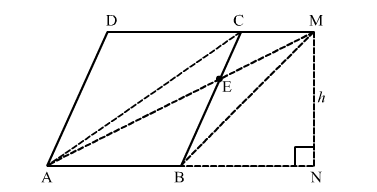Question:
In a parallelogram ABCD, any point E is taken on the side BC. AE and DC when produced meet at a point M. Prove that
ar(∆ADM) = ar(ABMC)
Solution:

Join BM and AC.
$\operatorname{ar}(\Delta \mathrm{ADC})=\frac{1}{2} b h=\frac{1}{2} \times \mathrm{DC} \times h$
$\operatorname{ar}(\Delta \mathrm{ABM})=\frac{1}{2} \times \mathrm{AB} \times h$
AB = DC (Since ABCD is a parallelogram)
So, ar(∆ADC) = ar(∆ABM)
Hence Proved
